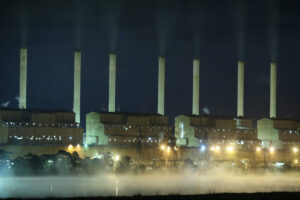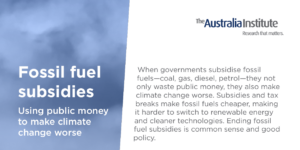Farmers know you can’t fatten a pig on market day and scientists know you can’t reduce greenhouse gas emissions by 2030 while expanding coal, oil and gas production.
But that is what is happening, according to the new 2023 Production Gap Report, which shows that major fossil fuel producing countries, including Australia, plan to produce double the fossil fuels in 2030 than allowed if we are to limit global warming to 1.5 degrees.
That’s a recipe for crop failure, intense drought, frequent bushfires, loss of native species, regional instability, extreme heat and disasters caused by extreme weather. Climate change is already wreaking havoc in every corner of the globe, not least Australia, as fossil-fuel-derived CO2 emissions reached a record high in 2022.
Anyone who shops at a supermarket knows that climate change is already increasing the costs of food, as drought becomes more frequent and production is affected by lower crop yields and livestock stress. But farmers are also facing higher operating costs, including water, insurance premiums and higher loan repayments, as well as the costs of natural disasters due to more frequent and intense severe weather events.
The Production Gap Report tracks the discrepancy between governments’ planned fossil fuel production and global production levels consistent with limiting warming to 1.5°C or 2°C. Basically, are governments walking the walk, or just talking the talk? The answer is just as unsurprising as it is alarming.
One thing the report demonstrates is that Australia has a unique role in reducing global emissions as one the world’s largest fossil fuel exporters.
There is no scenario in which new gas and coal mines are compatible with a 1.5°C world. Yet the chapter on Australia, citing Australia Institute research, demonstrates that Australia has more than 100 new fossil fuel projects on the Federal Government’s annual Resource & Energy Major Project list, as well as providing billions in subsidies to our fossil fuel sector, which in return contributes little to no tax.
It also notes, “There is no national policy framework aiming to restrict fossil fuel exploration, production, or infrastructure development.”
The reality is, there isn’t a gap, but a Grand Canyon between the rhetoric and actions of governments around the world when it comes to reducing greenhouse gas emissions, including Australia. Oil, gas and coal companies are making a pigsty of our atmosphere and environment, but only governments can rein them in.
Instead of reining in fossil fuel companies, Australia subsidies the oil, gas and coal industries to the tune of $11 billion a year, and that’s if you’re being conservative like the Australia Institute. The International Monetary Fund, which takes into account the true cost of carbon pollution, including the uncompensated costs of climate, health and other environmental damage into the definition of fossil fuel subsidies (i.e. the fossil fuel industry pollutes for free) put the cost at US $44 billion in 2020, including unpaid costs of air pollution and climate change.
And Australia is starting to feel the heat of international scrutiny as it bids to host COP31 in 2026, hopefully in partnership with a Pacific Islands nation.
Germany’s international envoy on climate, Jennifer Morgan, was in Australia this week on her way to the Pacific Island Forum and she called on the government to support a push by Germany and the European Union for a phase-out of fossil fuels at the next UN climate summit, saying the world does not “have the time any more” to go slowly on emissions reduction.
“Of course, every country has to figure out its own plan. But to keep 1.5 degrees in sight, this is what we have to do. And if we don’t keep 1.5 degrees in sight and we go over that, the cost – I mean, the lives of people and the cost to our societies and our economies – it goes almost out of control,” said Morgan.
As the Pacific Islands Forum got underway in the Cook Islands the Australian Government’s commitment of $11bn in annual fossil fuel subsidies was in the spotlight.
“That’s seven times the amount of money it would take to fund a renewable energy transition for eight Pacific countries,” pointed out Auimatagi Joe Moeono-Kolio, an adviser to the Fossil Fuel Non-Proliferation Treaty Initiative.
This reality is hard to miss. The Pacific Elders’ Voice published open letters in four countries – Australia (in this masthead), Fiji, the Cook Islands and New Zealand to publicly call on the Australian Government to stop fossil fuel subsidies and end fossil fuel expansion.
Meanwhile, new data from the Australian Tax Office shows that most of you reading this column will have paid more tax than many fossil fuel companies – so don’t listen to their nonsense about being the backbone of the economy.
While BHP and Rio Tinto were among the biggest corporate taxpayers, other mining companies like ExxonMobil, Shell and Chevron raked in billions of dollars in profit and paid not one dollar of corporate tax in 2021-22, according to the ATO.
Chevron has raked in nearly $100 billion in revenue over the past nine years, yet paid corporate zero tax for nine years in a row now, pointed out the Australasian Centre for Corporate Responsibility.
That’s what makes a windfall profits tax an economic ‘no brainer’, as Nobel laureate economist Joseph Stiglitz put it.
Australia has already lost out in tens of billions of dollars in revenue from our mining sector, but that doesn’t mean we have to keep doing it. If fossil fuel companies paid their fair share, revenue could be used to pay down debt, or invest in the clean energy transition, or disaster relief in the wake of extreme weather supercharged by climate change, caused by the fossil fuel industry.
The fact is fossil fuel companies are living high on the hog while Australians are struggling with a cost of living crisis, that climate change will only make worse. But knowing the political power of the fossil fuel industry in this country, pigs will fly before anything changes.
Between the Lines Newsletter
The biggest stories and the best analysis from the team at the Australia Institute, delivered to your inbox every fortnight.
You might also like
Climate target malpractice. Cooking the books and cooking the planet.
As the Albanese government prepares to announce Australia’s 2035 climate target, pressure is mounting to show greater ambition.
Fossil fuel subsidies
When governments subsidise fossil fuels—coal, gas, diesel, petrol—they not only waste public money, they also make climate change worse. Subsidies and tax breaks make fossil fuels cheaper, making it harder to switch to renewable energy and cleaner technologies. Ending fossil fuel subsidies is common sense and good policy.
Why a fossil fuel-free COP could put Australia’s bid over the edge
When the medical world hosts a conference on quitting smoking, they don’t invite Phillip Morris, or British American Tobacco along to help “be part of the solution”.


